Happo no Kuzushi:
Destroying Your Opponent's Balance
By Ronald L. van de Sandt
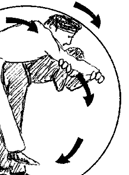 Tom
was learning some new techniques at the local karate school. Tom was a
5th Kyu, and his Sensei was teaching and demonstrating one of the basic
karate principles of motion. At his Sensei's order, Tom threw a right
hand punch right at his teacher's face - full force. Suddenly, and with
apparent ease, his teacher moved slightly to Tom's left, out of the path
of the punch, while blocking and grabbing the punch with his left hand.
Spinning to the left, his teacher then grabbed Tom's gi (uniform) at the
shoulder and quickly bent forward, twisting a little at the waist, and
placing his hip against Tom's waist. When his sensei pulled down on Tom's
wrist and shoulder, Tom felt himself lose balance, then he felt his feet
leave the floor. As Tom effortlessly passed over his teacher's hip, he
felt his feet travel in an arch over his head as he landed on his shoulders
with a thump - slapping the ground hard with his left hand to absorb the
impact. His instructor had performed a classic one-armed throw. The whole
event seemed to Tom as if he had been traveling in slow motion. "Man,
am I glad I practiced break-falling when Sensei told me too!" Tom
thought to himself, amazed at the speed and ease with which his Sensei
had taken him to the ground. Tom
was learning some new techniques at the local karate school. Tom was a
5th Kyu, and his Sensei was teaching and demonstrating one of the basic
karate principles of motion. At his Sensei's order, Tom threw a right
hand punch right at his teacher's face - full force. Suddenly, and with
apparent ease, his teacher moved slightly to Tom's left, out of the path
of the punch, while blocking and grabbing the punch with his left hand.
Spinning to the left, his teacher then grabbed Tom's gi (uniform) at the
shoulder and quickly bent forward, twisting a little at the waist, and
placing his hip against Tom's waist. When his sensei pulled down on Tom's
wrist and shoulder, Tom felt himself lose balance, then he felt his feet
leave the floor. As Tom effortlessly passed over his teacher's hip, he
felt his feet travel in an arch over his head as he landed on his shoulders
with a thump - slapping the ground hard with his left hand to absorb the
impact. His instructor had performed a classic one-armed throw. The whole
event seemed to Tom as if he had been traveling in slow motion. "Man,
am I glad I practiced break-falling when Sensei told me too!" Tom
thought to himself, amazed at the speed and ease with which his Sensei
had taken him to the ground.
This story demonstrates a very basic principle of motion called in Japanese
"Happo No Kuzushi." Happo literally means eight (or all) directions
and Kuzushi means to destroy or break down. So this is the principle of
how to destroy an opponent's balance in eight, or any, directions (Fig.
1).
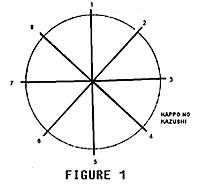
This principle, is the first of three rules that every Jujutsu and Judo
student knows, and every martial artist should know.
In order to make any technique work, you must:
1. Break the opponent's balance
2. Enter (position for) the technique
3. Complete (perform) the technique
Scientifically this principle encompasses and uses Newton's three laws
of motion:
1. An object at rest tends to stay at rest and an object in motion
tends to stay in motion with the same speed and in the same direction
unless acted upon by an unbalanced force.
2. An object will only accelerate if there is net or unbalanced force
acting upon it. The presence of an unbalanced force will accelerate
an object - changing its speed, its direction, or both (its speed and
direction).
3. For every action there is an opposite and equal reaction.
Simply put, it means that when an opponent throws a technique at you,
scientifically you should be able to redirect, add to, and/or unbalance
the force used on you, increasing the speed of the force at the same time.
But first, you have to know why and how to apply unbalancing force. By
applying an unbalancing force, you effectively use an opponent's own force
against himself. It all starts with the circles around you.
Happo no Kuzushi - the Principle of the Ball
Keeping Newton's laws in mind, picture a ball - circular in every direction.
Picture how most objects in the universe relate to a ball, and you can
begin to understand the principle of the ball. The (round) moon circles
the (round) earth which in turn circles the (round) sun, etc. - each reacting
to the other (in a circular fashion). This is the way of the universe.
On earth, there is always an unbalancing force called gravity, which creates,
or can be viewed as, the weight of an object. Gravity then acts upon all
of the other forces that may be generated by our bodies, or objects around
us. Therefore, most physical forces on earth, because of gravity, travel
in a circle, or can be pictured as a ball (a circle in every direction).
The size of the ball is determined by the size of the object itself, other
objects that the ball is in relation with, and the forces being applied
to it. Another good example of this phenomenon is the arched trajectory
of an arrow when it is shot at a distance. The size of it's "ball"
is controlled by the force that sent the arrow, the mass (size) of the
arrow itself, and the gravity pull of the earth (weight of the arrow).
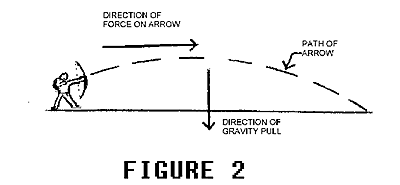
The three elements acting together cause the trajectory of the arrow
to arch (Fig. 2).
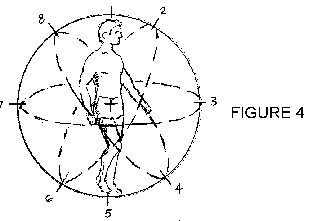
Now picture the human body having an invisible ball around it that is
as big around as its height (Fig.4). Leonard Da Vinci depicted the ball
around our bodies in a sketch that showed the form of a man contained
within a circle (or ball) similar to Fig. 3.
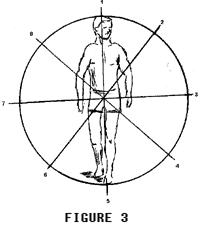
Notice that Figures 3 and 4 both have eight directions to it, hence the
name of this principle.
If we go back to the story, when Tom punched at his Sensei's face, his
force was directed toward the top of his sensei's ball. Since his sensei
placed himself (and his hips) at the center of the ball, Tom's motions
become the outer areas of the ball, so when he is thrown, the sensei's
ball rolls forward. As his sensei bends at the waist, the ball becomes
smaller and faster, and Tom's body takes the shape of the outside of the
ball. In addition, because of Newton's second law of motion, Tom's initial
forward motion changed direction, and increased in speed due to his teacher's
use of unbalancing force. As Tom travels the outside of the ball, his
head and shoulders travel toward the downward side of the ball while his
feet travel up toward the upward side, illustrating Newton's second and
third law of motion (Fig. 5).
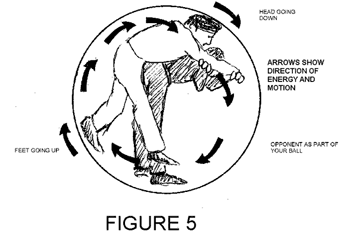
The same principle would work no matter which direction
the "ball" rolled, such as if Tom had kicked low and the ball
rolled in the opposite direction. His body would still continue moving
in the shape of the ball (circle) until another force stopped him, such
as the ground, thus illustrating Newton's first law of motion. Destroying
your opponent's balance means you are forcing him out of his ball, and
making him become the outer part of your ball. An opponent's balance must
be broken before a technique such as a throw can be properly applied.
Many times Judo and Jujutsu stylists will break the opponent's balance
by either pulling or pushing suddenly against the opponent.
These are the principles that martial artists should utilize and exploit
very extensively. You can readily see the shape of this ball in virtually
every throw performed. When an opponent is charging you, if you stop one
point on the opponent's body such as the head, the rest of the body has
to continue the force, and you have now effectively changed it's direction
from straight line to a circular (ball) path. If you stop the feet, the
ball rolls forward, and the head goes down. Using this principle you can
now redirect the other person's force to your advantage, and from any
of the eight directions.
This can be seen very clearly in a game of pool. The pool player calculates
the spin of his cue ball (you) and its effect on the other balls (attackers)
on the table. If the cue ball is spinning upward because the cue stick
struck the cue ball below its centerline, upon contacting another ball,
the other ball will spin the opposite direction (downward). (See Fig.
6)
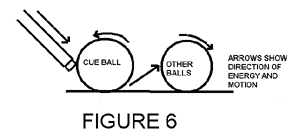
A good pool player becomes very adept at controlling the direction and
speed of the cue ball, and other balls on the table. This is how they
can make a ball curve away from them, toward them, and go forward, backward
or around another object, and stop exactly where they planned. As a martial
artist, if you truly learn and understand this "principle of the
ball" like a pool player, you can control situations and opponents
in the same basic manner.
Since this principle is based on natural laws of physics, the principle
works well in everyday life too. Have you ever approached a heavy door,
and then planted both feet to get enough force to open it? If so, then
try this instead: as you approach the door and reach out for the handle,
keep one foot back. Then, picturing the motions of a ball, allow your
whole body weight to go back, rocking onto the reserved foot. You are
utilizing the ball principle by using the force of your body weight, while
at the same time keeping your own balance. If someone from the other side
pushes, and the door swings too quickly toward you, you'd normally lose
your balance because you have planted both feet. By using this same technique
you again use the ball principle, the back foot catches you, still keeping
you on balance. Now try to look around and apply this technique in other
areas in your life. How do you walk, sit, dance, and push a car? The applications
become endless, since the principle is based on the physics of motion.
The bottom line is that everyone uses the ball principle everyday, without
realizing it. Because the principle is simply the physics that act on
us in our every movement, we tend to ignore and not pay attention to why
things move and act as they do, and therefore sometimes the ball principle
works against us. By understanding, applying, and practicing the art of
balance breaking called "Happo no Kuzushi" in your everyday
life, you begin to work with nature, not against it. In so doing, you
also develop the skill of balance keeping, as well as balance breaking,
in both your martial arts, and in your everyday life.
About The Author:
Ron van de Sandt has been in the martial arts since 1972 and has studied
American Kempo, Shorin Kempo and Sholin Karate - a blend of Shorinji
Ryu and Shorin Ryu Karate. Mr. van de Sandt currently holds a Dan rank
in Sholin Karate, and runs the Sholin Karate Club, at the Fairborn YMCA,
Fairborn, Ohio.
|